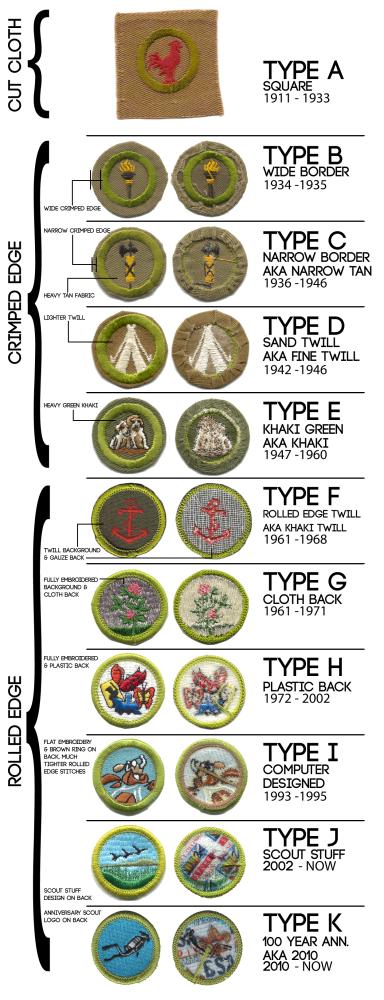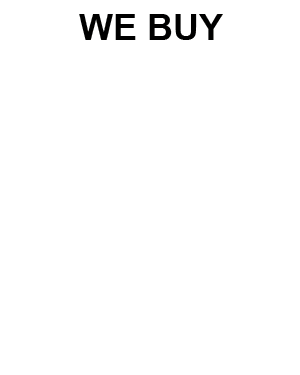Type A | Dates: 1911-1933 | Nickname: Square
Identification: Type A badges were the first produced and issued for Scouts. They were originally made on large rolls with many badges and then they were cut out into squares with the badge embroidered. They are referred to by collectors as “Squares” because of the shape of the fabric.
Value: Type A badges are desirable to collectors, value depends greatly on condition and the specific merit badge.
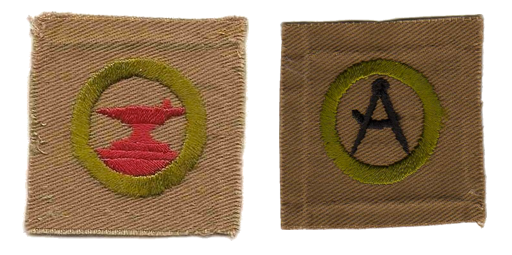
Type B | Dates: 1934-1935 | Nickname: Wide Border
Identification: Type B badges were the first round badges, the shape was formed by folding the edge of the fabric back down on the reverse side, and referred to as a crimped edge (see picture of reverse). All badges from Type B to Type E have this crimped edge. Type B is only distinguished from Type C by the width of the border from the embroidery of the badge to the crimped edge of the fabric. A Type B badge should have a border approx. 3/16″ to 1/4″ and a total diameter of approx. 1-3/4″.
Value: Type B badges were only produced for around two years so they are pretty scarce and uncommon badges can be valuable.
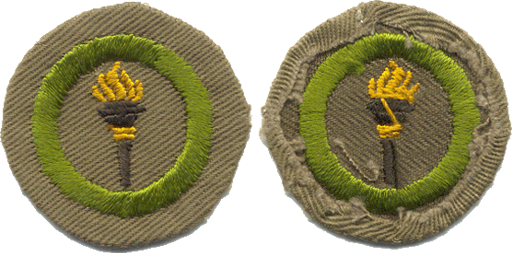
Type C | Dates: 1936-1946 | Nickname: Narrow Border or Narrow Tan
Identification: Type C badges look the same as Type B (Wide Border) badges, they were made on the same cloth, but the border of cloth outside of the embroidered edge of the badge is much narrower, hence the name. Diameter of Type C badges should be approx. 1-1/2″ with approx. 1/8″ border. Normal Merit Badges switched to the Type D production around 1942, but Air Scouts Badges were produced as Type C until 1946 (these are easy to distinguish because they had blue backgrounds and borders).
Value: Type C Badges are much more common than Type A or B, and will be valuable if they are a rare badge that not many scouts earned.
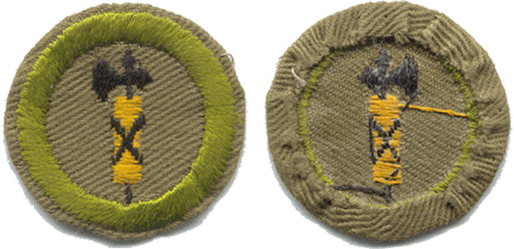
Type D | Dates: 1942-1946 | Nickname: Fine Twill / Sand Twill
Identification: The cloth used to make Type D badges is a much lighter and finer weave than the cloth used to make Type C badges, this is because the heavier cloth was being used for the war effort at the time, the different cloth used is the only difference from Type C, these badges still have the narrower border and crimped edge.
Value: Value for Type D is better than Type C because they were only made for a four year span, but they can still be found pretty easily at large events.
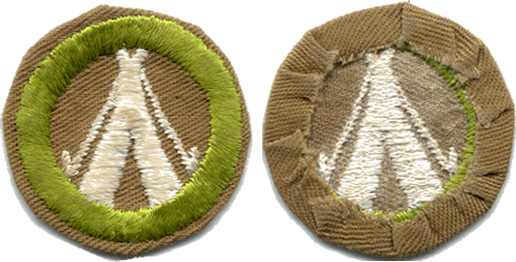
Type E | Dates: 1947-1960 | Nickname: Khaki Green / Khaki
Identification: Type E badges are similar to Type C with the narrow border, same cloth weight, and crimped edge, but the color of these badges has a much greener hue to it and that is the primary way to identify them. The difference can be tough to tell sometimes in poor light but if you have a sample of each type it’s pretty easy to distinguish.
Value: Type E badges are still easy to obtain and they sell for a couple dollars each for common badges like those required for Eagle, there are a few rare badges that can sell for decent amounts.
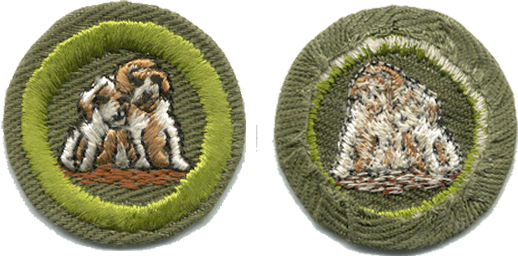
Type F | Dates: 1961-1968 | Nickname: Khaki Twill / Rolled Edge Twill
Identification: Type F are the first Merit badge to use a rolled edge where the border wraps around the back of the badge, this means it has no cloth border around the badge like the crimped edge types. Type F and Type G were introduced at the same time, the difference is that Type F have a twill cloth background and gauze or cheesecloth back, while Type G has a fully embroidered background and cloth backing.
Value: Type F badges are very easy to find and it’s not too much work to put together a complete set of these badges for an affordable price.
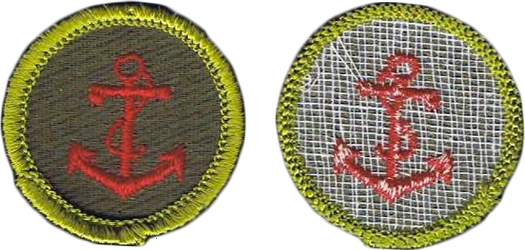
Type G | Dates: 1961-1971 | Nickname: Cloth Back
Identification: Type G badges have a rolled edge like Type F badges, but have a fully embroidered background on the badge and a cloth backing.
Value: Most Type G badges are easy to find but there are a couple that are somewhat rare because they were not available for very long.
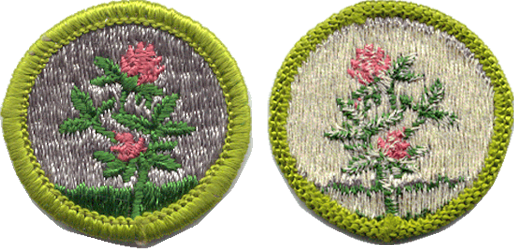
Type H | Dates: 1972-2002 | Nickname: Plastic Back
Identification: Type H badges are essentially the same badge you can buy today, they are fully embroidered and have a rolled edge like Type G badges, but they have a plastic back instead of a cloth backing. You will typically see Type H badges with a clear or milk white plastic back but some can be found with a blue plastic.
Value: Type H badges are exceptionally common, scouts were earning these badges very recently and it’s not very hard to collect a full set of these. You can save some money if you patiently trade for these compared to buying them, but they aren’t very expensive in the first place.
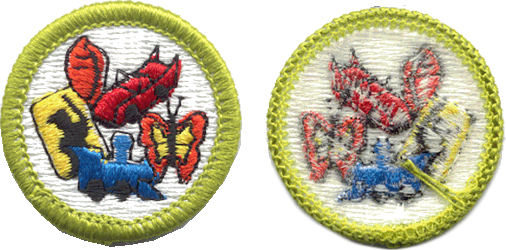
Type I | Dates: 1993-1995 | Nickname: Computer Designed
Identification: Type I badges were produced by computerized embroidery machines and they are identifiable because the stitching of the embroidery lays very flat on the badge, compared to a more raised design you will see in the older style embroidered badges. Frequently there is also a brown ring in the backside of the badge as a result of the computer process.
Value: These badges are still very common, but they were only produced on a few badges for a couple years so they may be rare in 50 or 60 years!
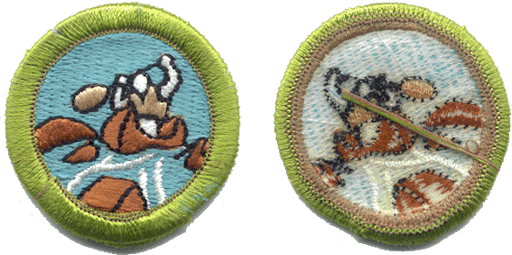
Type J | Dates: 2002-present | Nickname: Scout Stuff
Identification: Type J badges are pretty much identical to Type H badges except that the back has a Scout Stuff logo that is easy to distinguish and gives this type its name.
Value: Still being produced, you can buy these at most Scout Stores
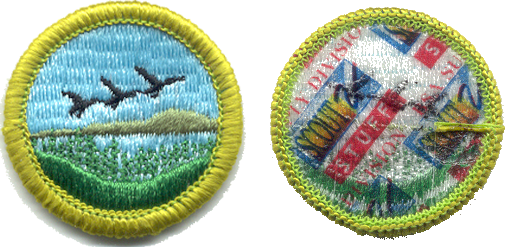
Type K | Dates: 2010 | Nickname: 2010 / 100 year Anniversary
Identification: Type K look the same as Type J or H, they simply have a different design to the back, instead of the Scout Stuff design you will see a special 100th Anniversary design.
Value: Very Common, these can be purchased at face value today.
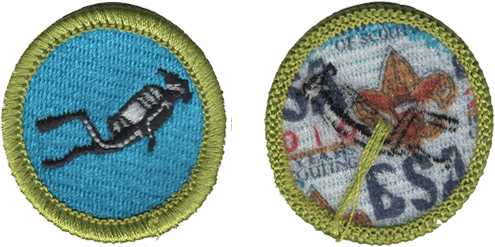
Shown below is a guide that shows the development of different badge types all together. For a better view, click on the image to see it full size.
